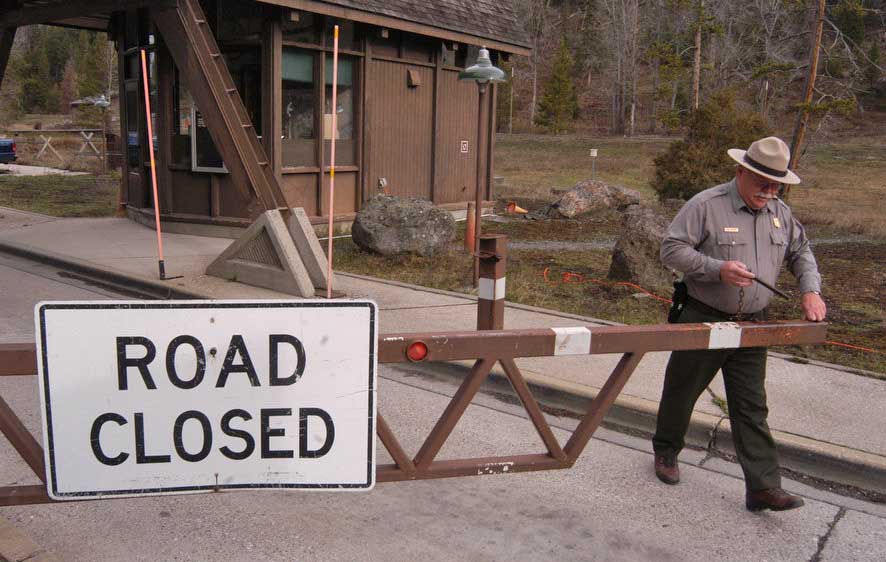
Dennis Lenzendorf opens the Yellowstone East Gate on Friday for the first day of the 2012 summer season. (Ruffin Prevost/Yellowstone Gate – click to enlarge)
By Ruffin Prevost
CODY, WYO. — Biologists working in Yellowstone National Park have devised elaborate and ingenious ways to track and count a wide range of elusive animals, ranging from collars that communicate with orbiting satellites to transmitters surgically implanted in live fish.
But social scientists in the park continue to struggle in fully understanding the movements of one of Yellowstone’s most visible and abundant species: homo sapiens.
Tracking the movements and usage patterns of people inside the park is important for managers and planners working to relieve congestion at popular spots like Old Faithful Geyser, for instance. But is is also key in helping to reduce the risk of conflicts between hikers and grizzly bears, as well as for a wide range of other reasons. Figuring out exactly how many people visit the park each year, not to mention how they spend their time in 2.2 million acres of rugged and remote terrain, is an evolving process.
Earlier this month at a science review conference on Old Faithful, Deputy Superintendent Steve Iobst said that social scientists were changing they way park visitation is calculated, and that park managers are looking for better data on how many people move through busy ares like the Old Faithful Visitor Center.
“How many people who come to Old Faithful today will go through the door of the visitor center five times?” he said. “Because that’s counted as five visits to the visitor center.”
The distinction may seem inconsequential, but when an estimated 25,000 visitors pass through the Upper Geyser Basin on a busy summer day, accurate head counts are needed for everything from food purchasing to sewage system management, and everything in between.
“We measure visits to Yellowstone by the number of vehicles, and then multiply by a set number,” Iobst said. That multiplier has been 2.91 people per vehicle for the past 20 years, but it is being changed to 2.58 based on new survey data gathered in the park last summer.
The result is that Yellowstone’s total visitation numbers this year will reflect an estimated .33 fewer people per vehicle.
The new multiplier of 2.58 is more in line with one that has long been used at Grand Teton National Park, said spokeswoman Jackie Skaggs.
A survey conducted in the early 1990s by the Park Studies Unit at the University of Idaho came up with a multiplier of approximately 2.6 for Grand Teton, she said.
“That’s encouraging to me that we’re going to be using the same multiplier,” Skaggs said of the change in how Yellowstone calculates visitors. “We had been scratching our heads trying to figure out why Yellowstone was reporting these higher numbers.”
Yellowstone typically reports significantly higher total recreation visitors than Grand Teton, but the differential showed up even when comparing visitors leaving the South Gate of Yellowstone and entering Grand Teton via the John D. Rockefeller, Jr. Memorial Parkway. Skaggs said visitor counts between the two parks wouldn’t match, with Grand Teton “losing” a suspiciously high number of visitors between adjacent gates.
With the two parks using more closely aligned multipliers, “it will be more like comparing apples to apples now,” she said.
But comparing this year’s visitation in Yellowstone to recent years won’t be, because previous years were calculated using a different multiplier. Skaggs said the Grand Teton multiplier change made in 1992 is always noted on long-term traffic tallies, and that trends over time are still apparent, despite using different multipliers. Vehicle counts made with physical traffic counters in both parks also offer a constant and consistent benchmark.
Like much of the rest of how national parks are managed, science is playing an increasingly important role, with managers relying more on social science, Skaggs said.
She said visitor surveys conducted a few years ago helped Grand Teton managers create more effective bear safety warning and education signs, and social science is being used to help with planning for the Moose-Wilson Road corridor.
“Social science is something we’re starting to use more of in part of our planning efforts, but I think it’s not as well understood as it could be,” she said. “Maybe we don’t give it enough credit.”
Contact Ruffin Prevost at 307-213-9818 or ruffin@yellowstonegate.com.

I’ve always considered ” Social Scientist” to be an oxymoron.
Behavioral Accountant might fit better…